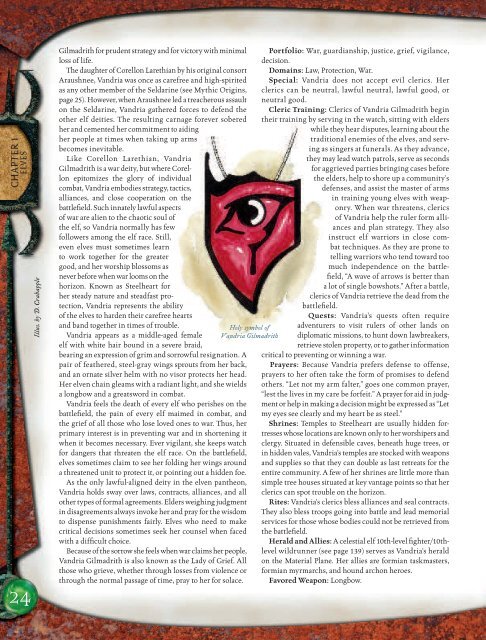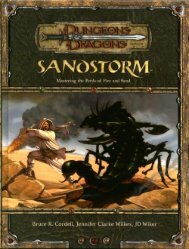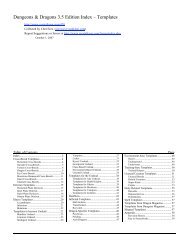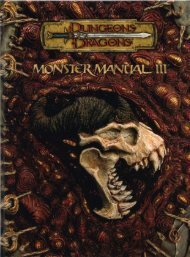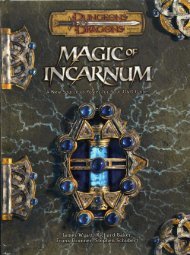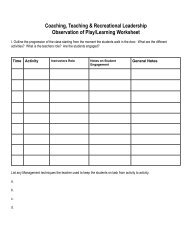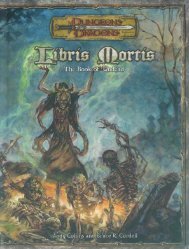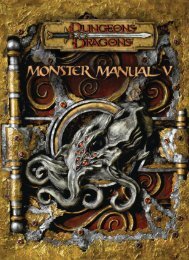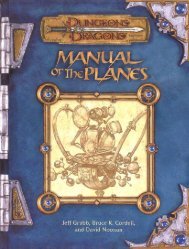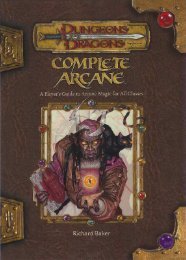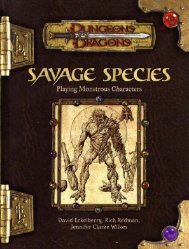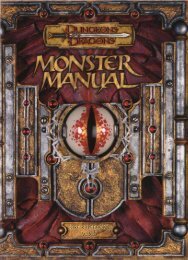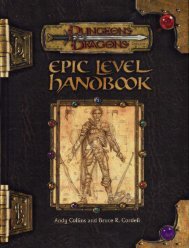CHAPTER 2HALFLINGS46Halfling caravans hold funerals to mourn the loss <strong>of</strong>companions and also to celebrate their next great journey.Thus, a funeral usually has two parts: a grieving ceremonyfollowed by a party. During the grieving portion <strong>of</strong> thefuneral, the entire community gives vent to sorrow. Theobject <strong>of</strong> this portion <strong>of</strong> the ritual is to cleanse the souls <strong>of</strong>those left behind <strong>of</strong> their grief so that they can move on, bothliterally and figuratively. After all members <strong>of</strong> the caravanhave cried as long as they need to, they sleep, then awakenand begin the celebration. Tables are set up with places foreveryone, including an empty spot for the deceased. Theyroast meat, pile baked goods <strong>of</strong> all sorts on crude woodentables, and tap barrels <strong>of</strong> wine and ale. Everyone eats, drinks,and dances. From time to time, someone stands up and tellsa story (<strong>of</strong>ten humorous) involving the deceased, and tales <strong>of</strong>his life are woven into stories to add to the general tapestry <strong>of</strong>oral tradition that ties all halflings together. The storytellingand feasting lasts until everyone has fallen asleep, usually afull day and night.After the party ends, the body <strong>of</strong> the deceased, if present,is brought to a funeral pyre built <strong>of</strong> branches and twigsand set alight. His ashes are then scattered to the fourwinds, so that he might continue his journey unfettered.The goods <strong>of</strong> the deceased are distributed to the remainingmembers <strong>of</strong> his family or, if no immediate family is present,to his clan.If a funeral is held for a halfling who later turns up alive,he must take another name because his original identity hasbeen laid to rest. Even if everyone knows who he is, he mustbegin again as a new member <strong>of</strong> the caravan and his clan.HALFLING SOCIETYAND CULTUREFor the most part, halflings lay no claim to any land, buildno permanent dwellings, and grow no crops. They functionas permanent guests in the world, moving from onecommunity to another, enjoying the hospitality <strong>of</strong> anyfriends they find, and moving along when they wear outtheir welcome. They carry with them only what fits in theirwagons, and they live <strong>of</strong>f the land when no other means <strong>of</strong>support presents itself.Some halflings do purchase land or homes and settle downfor a time, but these individuals rarely live out their lives inone spot. After a year or two the family moves on, taking tothe road again or seeking a new home in a different settlement.Halflings who settle down to stay are rare indeed,usually elderly folk who have seen all they wish to see andwant only a comfortable retirement. Some settled halflingsallow others <strong>of</strong> their kind to camp on their land and help farmit whenever they pass through. Others settle in cities andprovide safe houses for halflings who are in trouble with thelaw. Whatever their dwellings, settled halflings <strong>of</strong>ten serveas fences or “bankers” for other halflings; they provide a safeplace to cache accumulated wealth so the owner doesn’t haveto carry it and risk losing it to brigands.Permanent halfling communities are generally found inthe lands <strong>of</strong> other races, and their populations turn over withsome regularity. Such communities <strong>of</strong>fer services to travelinghalflings, give them items left behind by others, and providesafe places for them to hide or store wealth, in the same waythat individual settled halflings might. A halfling in such acommunity may at any point trade her shop for a wagon andmove on with a passing caravan, leaving some other halfling(usually from the same clan) in charge <strong>of</strong> her business for aslong as the newcomer wishes to stay.Some halfling communities, whether caravans or settlements,also include a few outsiders who have been “adopted”by one clan or another. Such individuals are usually foundlingswho were left at a halfling camp by parents who did notwant them, or orphans the halflings found in their travels.Halflings raise such adoptees with all the privileges <strong>of</strong>membership in the clan but still expect them to leave uponreaching maturity. If an adoptee takes poorly to life on theroad, the halflings may try to find her a home in the nextcommunity <strong>of</strong> her kind that they encounter. Alternatively,adoptees may find their way to a permanent halfling settlement,where an elderly shopkeeper may be happy to have thecheap labor that a child represents.The following sections describe the framework <strong>of</strong> a halflingcaravan community, the lifestyle <strong>of</strong> a lone halfling,and the structure <strong>of</strong> a settled community, as well as some<strong>of</strong> the details <strong>of</strong> mundane aspects <strong>of</strong> daily life in each <strong>of</strong>these settings.Roleplaying Application: The day-to-day aspects <strong>of</strong>halfling society include those elements that are consideredcommon knowledge, the basic assumptions that halflingsmake about the world. Consider how these assumptions affectyour character’s attitude and how the different customs <strong>of</strong>others might spark his innate curiosity.HALFLING CLANSHalfling clans are groups tied together by family relationships.The precise details <strong>of</strong> how clan membership is decidedvary from one clan to another, but in most cases a halfling istechnically a member <strong>of</strong> both her mother’s and her father’sclan at birth. Upon reaching maturity, she must formallychoose between the two clans and adopt the family name <strong>of</strong>the chosen clan. Informally, however, she usually remainswelcome with the clan she did not choose and may travelwith either at will.Should a halfling commit so heinous an act that his clanwishes to disassociate itself from him, the clan ruler maychoose to eject him. At that point, he may formally join anyother clan that will have him. If no clan ruler is willing toaccept him, he becomes a clanless loner.Clanless halflings do not suffer from the same degree <strong>of</strong>stigma as clanless dwarves do, but they can still expect to betreated with some wariness by others <strong>of</strong> their kind. Most driftfrom one caravan to another, always claiming membershipin a clan not represented there, or make their own way in thesociety <strong>of</strong> some other race.
A chief or elder heads each clan, chosen by acclaim atclan gatherings that take place every five years (or sooner,in case <strong>of</strong> an elder’s untimely death). The clan ruler handsdown clan law, decides major disputes, and generally directsthe activities <strong>of</strong> the clan. A council <strong>of</strong> clan leaders from variouscaravans advises him. The composition and size <strong>of</strong> thecouncil varies with the movements <strong>of</strong> the caravans, but theclan leaders in whatever caravans are camped within twentymiles <strong>of</strong> the leader’s caravan at any given time are expectedto be at the ruler’s beck and call.Periodically, clan rulers gather to map out strategy. Theyexamine the clans’ recent travels, discuss which other racescan be expected to welcome them and which they have<strong>of</strong>fended, what opportunities for work may be opening updue to wars, natural disasters, and rapid expansion or collapse<strong>of</strong> other humanoid settlements. Then they decide upon theoverall movements <strong>of</strong> the halfling race for the immediatefuture, making note <strong>of</strong> potentially hostile areas as well asthose communities expected to welcome their presence.Within a particular caravan or settlement, the members<strong>of</strong> a clan answer to the senior member <strong>of</strong> that clan. Shouldthe senior member be too old or infirm to function as clanleader, the next oldest member assumes the responsibility.The clan leader must give permission for all marriages andfor transactions involving significant property (such aswagons). The leader also resolves disputes between clanmembers and decides who will take care <strong>of</strong> the family <strong>of</strong> adead or injured member.FAMILY UNITSThe nuclear family is the foundation <strong>of</strong> halfling society.A handfasted or married couple lives together in a singlewagon or home. Once a child is born, one or both parentsraise it to maturity. The community plays a significant rolein the development <strong>of</strong> youngsters because everyone knowswhat everyone else is doing. Though young halflings dosometimes manage to sneak away from the camp or townand get into trouble, such incidents are rare. The halflingshave long ago learned that failure to keep their mischievouschildren corralled does not endear them to the members <strong>of</strong>other races among whom they may be living. Upon reachingmaturity, a halfling may choose to continue living withhis parents or strike out on his own, with the blessing <strong>of</strong>the community.Younger families usually <strong>of</strong>fer widowed or disabled elderlyrelatives a place in their wagon. Beyond that, however,extended families usually do not occupy the same wagons—uncles, aunts, and cousins traveling with the same caravantypically have their own families and their own wagons.Illness and AgingWhen a member <strong>of</strong> a caravan or settlement falls ill or isdisabled, other members take over her tasks and care for heruntil she recovers. No recompense is expected on her part;instead, she is expected to pitch in and help in turn whensomeone else encounters misfortune.Elderly traveling halflings <strong>of</strong>ten stay with their caravansuntil they can no longer tolerate the rigors <strong>of</strong> life on the road.Many never reach this point and simply die “en route.” Othersgradually realize that they no longer enjoy the traveling lifeand leave the caravan to settle down. Those with sufficientfunds sometimes buy property within human, elf, or dwarfcommunities and set themselves up as artisans or merchants.Others settle in a permanent halfling settlement and live outtheir retirement with others <strong>of</strong> their kind.WANDERERSMost halflings spend the majority <strong>of</strong> their lives travelingby either land or sea. They usually travel in large groups,though it is not uncommon for individual halflings to strikeout on their own.CaravansHalflings who wander the wilderness usually do so incaravans. A halfling caravan may be <strong>of</strong> any size; a typicalone consists <strong>of</strong> twenty-five to thirty-five wagons. Such anumber ensures that the caravan makes a formidable targetfor monsters or brigands but still allows the wagons to spreadout in a campsite without too much crowding.A caravan may consist <strong>of</strong> only a single clan, but such asituation is rare. Usually, three to eight clans are representedin a single caravan. The clan composition <strong>of</strong> a given caravanis fluid because families are always free to leave for othercaravans or strike out on their own.Though outsiders <strong>of</strong>ten consider halfling caravans to benothing more than a chaotic jumble <strong>of</strong> wagons, these rollingcommunities are in fact structured and stable organizations.Each member <strong>of</strong> a caravan has his place and his specific tasksto perform, and each is both welcome and needed.Everyone in a halfling caravan has a primary task to perform.Each person also has the skills to perform one or twoother functions. Thus, if tragedy should befall the caravan’sblacksmith, someone else in the group can take over thatfunction right away.Young halflings receive basic instruction in most <strong>of</strong> thetasks associated with daily life. When a youngster displaystalent and interest in one particular kind <strong>of</strong> task or craft(usually by the age <strong>of</strong> 10), she is informally apprenticed tothe master <strong>of</strong> that trade in the caravan for the next five years.When she reaches the age <strong>of</strong> 16, she is apprenticed to a master<strong>of</strong> a different craft. Each year thereafter until she reachesmaturity at 20, she studies a different craft under a differentmaster. Thus, almost every member <strong>of</strong> the caravan possessesat least one rank in several different skills commonly used inthe caravan. When a young halfling reaches the age <strong>of</strong> 20, shemay choose to strike out on her own or to stay and practiceany one <strong>of</strong> her crafts in the caravan.WagonsHalfling wagons range from family-sized conveyances(occupied by six or more people and pulled by oxen ora team <strong>of</strong> horse) to smaller wagons scarcely bigger thanCHAPTER 2HALFLINGS47
- Page 2: C R E D I T SD E S I G NSKIP WILLIA
- Page 7 and 8: no elf could predict which memory w
- Page 9 and 10: premium. Thus, each individual can
- Page 11 and 12: The elves have raised one form of e
- Page 13 and 14: do spend time away from one another
- Page 15 and 16: espects during this time, and those
- Page 17 and 18: Stores Master: Charged with keeping
- Page 19 and 20: would be the birthright of any full
- Page 21 and 22: of feet above the forest floor. Mos
- Page 23 and 24: Cleric Training: More than any othe
- Page 25 and 26: ELF HISTORYAND FOLKLOREThe elves cl
- Page 27 and 28: along with her son Hionyron, who wa
- Page 29 and 30: and return her to her people.” In
- Page 31 and 32: Table 1-3: Suffixesd% Suffix Meanin
- Page 34: CHAPTER 1ELVES34tri-level tree home
- Page 37 and 38: Illus. by C. Lukacsurious and activ
- Page 39 and 40: the reason for the farmer’s hospi
- Page 41 and 42: Halflings make a visitor feel welco
- Page 43 and 44: Halflings are usually pleasant trav
- Page 45: Halflings are as eager to experienc
- Page 50 and 51: CHAPTER 2HALFLINGS50away from their
- Page 52 and 53: CHAPTER 2HALFLINGS52Illus. by S. Wo
- Page 54 and 55: CHAPTER 2HALFLINGS54to tell how lon
- Page 56 and 57: CHAPTER 2HALFLINGS56the underbrush
- Page 58 and 59: CHAPTER 2HALFLINGSIllus. by T. Baxa
- Page 60 and 61: CHAPTER 2HALFLINGS60Donta muden sit
- Page 63 and 64: and one or more bedrooms. All have
- Page 65 and 66: Illus. by C. Lukacshe cliff-dwellin
- Page 67 and 68: Personality: Raptorans have a reput
- Page 69 and 70: PSYCHOLOGYSome outsiders who have h
- Page 71 and 72: for making a point through a logica
- Page 73 and 74: flock for debate, sometimes invitin
- Page 75 and 76: its eggs. At such times, they toler
- Page 77 and 78: THE RAPTORAN PANTHEONThe typical ra
- Page 79 and 80: Prayers: Prayers to the Stormfather
- Page 81 and 82: “Welcome, friend,” said a human
- Page 83 and 84: year since, and they share the care
- Page 85 and 86: D: Domain spell. Domains: Protectio
- Page 87 and 88: characteristics are summarized in t
- Page 90 and 91: CHAPTER 3RAPTORANS90Authority Figur
- Page 92 and 93: CHAPTER 4OTHERRACES92a humanlike ra
- Page 94 and 95: CHAPTER 4OTHERRACES94ment, finding
- Page 96 and 97:
CHAPTER 4OTHERRACES96Illus. by S. B
- Page 98 and 99:
Table 4-1: The CentaurHit Base Atta
- Page 100 and 101:
CHAPTER 4OTHERRACES100nomadic gnoll
- Page 102 and 103:
Table 4-2: The GnollBase Fort Ref W
- Page 104 and 105:
CHAPTER 4OTHERRACES104of the humano
- Page 106 and 107:
CHAPTER 4OTHERRACESsneak attack, bu
- Page 108 and 109:
CHAPTER 5PRESTIGECLASSES108Shadowda
- Page 110 and 111:
CHAPTER 5PRESTIGECLASSESIllus. by W
- Page 112 and 113:
CHAPTER 5PRESTIGECLASSES112the foll
- Page 114 and 115:
CHAPTER 5PRESTIGECLASSES114Entry Re
- Page 116 and 117:
CHAPTER 5PRESTIGECLASSESIllus. by J
- Page 118 and 119:
CHAPTER 5PRESTIGECLASSESLUCKSTEALER
- Page 120 and 121:
CHAPTER 5PRESTIGECLASSESIllus. by J
- Page 122 and 123:
CHAPTER 5PRESTIGECLASSESEL 11: Kuly
- Page 124 and 125:
CHAPTER 5PRESTIGECLASSES124spellcas
- Page 126 and 127:
CHAPTER 5PRESTIGECLASSES126save bon
- Page 128 and 129:
CHAPTER 5PRESTIGECLASSESmore than o
- Page 130 and 131:
CHAPTER 5PRESTIGECLASSES130raptoran
- Page 132 and 133:
CHAPTER 5PRESTIGECLASSES132Table 5-
- Page 134 and 135:
CHAPTER 5PRESTIGECLASSESfriendly—
- Page 136 and 137:
CHAPTER 5PRESTIGECLASSESYou no long
- Page 138 and 139:
CHAPTER 5PRESTIGECLASSES138small fe
- Page 140 and 141:
CHAPTER 5PRESTIGECLASSES140ranger.
- Page 142 and 143:
CHAPTER 5PRESTIGECLASSESIllus. by T
- Page 144 and 145:
CHAPTER 5PRESTIGECLASSESEncountersP
- Page 146 and 147:
CHAPTER 6CHARACTEROPTIONS146Conditi
- Page 148 and 149:
CHAPTER 6CHARACTEROPTIONS148If the
- Page 150 and 151:
CHAPTER 6CHARACTEROPTIONSIllus. by
- Page 152 and 153:
CHAPTER 6CHARACTEROPTIONSIllus. by
- Page 154 and 155:
CHAPTER 6CHARACTEROPTIONSIllus. by
- Page 156 and 157:
Table 6-3: Elf Ranger Racial Substi
- Page 158 and 159:
Table 6-5: Halfling Druid Racial Su
- Page 160 and 161:
CHAPTER 6CHARACTEROPTIONS160Table 6
- Page 162 and 163:
Class SkillsRaptoran fighter substi
- Page 164 and 165:
CHAPTER 7EQUIPMENTAND MAGICIllus. b
- Page 166 and 167:
CHAPTER 7EQUIPMENTAND MAGIC166anoth
- Page 168 and 169:
CHAPTER 7EQUIPMENTAND MAGICTable 7-
- Page 170 and 171:
CHAPTER 7EQUIPMENTAND MAGICIllus. b
- Page 172 and 173:
CHAPTER 7EQUIPMENTAND MAGICIllus. b
- Page 174 and 175:
2nd-Level Ranger SpellWoodland Veil
- Page 176 and 177:
WOODLAND VEILIllusion (Glamer)Level
- Page 178 and 179:
CHAPTER 8CAMPAIGNS INTHE WILD178THE
- Page 180 and 181:
CHAPTER 8CAMPAIGNS INTHE WILDIllus.
- Page 182 and 183:
CHAPTER 8CAMPAIGNS INTHE WILD182(lo
- Page 184 and 185:
CHAPTER 8CAMPAIGNS INTHE WILD184Ski
- Page 186 and 187:
CHAPTER 8CAMPAIGNS INTHE WILD186Tab
- Page 188 and 189:
CHAPTER 8CAMPAIGNS INTHE WILDIllus.
- Page 190 and 191:
CHAPTER 8CAMPAIGNS INTHE WILDIllus.
- Page 192:
APPENDIX19261 Guards are needed to
- Page 195 and 196:
2THE CLIFFThe Rifinti dwelling lies
- Page 198 and 199:
supplies for craftwork. Lamps fuele
- Page 200 and 201:
Nae’fidrim: Female owl companion;
- Page 202 and 203:
Creatures: A cleric is always on du
- Page 204 and 205:
cloak of elvenkind, oil of magic we
- Page 206:
aptoran contraries. If visitors can


